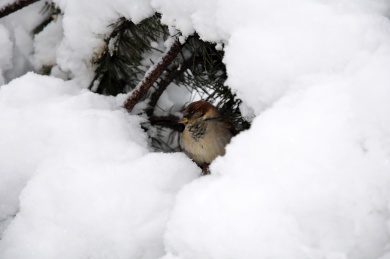With the possibility of bitterly cold winds, rain and snow in the UK through the winter. Now is the perfect time to make sure your garden’s equipped to help a feathered friend out. Here are some ways and simple ways to look after birds.
It’s a tough time for wild birds in the garden over winter. As the temperature plummets, most of their energy is used up on keeping themselves warm. However, the more energy they use, the more food they need to be able to re-generate more energy again. Finding food to replenish those reserves is not an easy task. When the ground is frozen over and other natural sources have died back for the season. But we can give a little assistance to these hard workers, helping to increase their chances of survival in a few simple steps.
Food

The easiest way in which we can help is by placing out food when their natural sources are scarce. The thing to remember when feeding wild birds is what type of food they’re really going to benefit from. Packs of bird seed are readily available, but it’s a good idea to check out the content of the mix. Lots of cheaper mixes are filled out with materials such as lentils and split peas. The majority of smaller and more common garden birds can’t eat these foods dry. In winter in particular you want to look at for high fat/high energy food such as fat/suet balls and cakes. Peanuts are also high in fat so are a popular winter snack.
You can take a look at our own range of bird food and feeders
If you’ve run out of prepared bird food, there’s plenty of food from your kitchen that can be used as a replacement. But remeber to follow guidelines from the RSPB carefully, as there are lots of food that can be equally as bad for wild birds.
Plain cooked white or brown rice is a beneficial substitute during a big freeze. This will please a variety of different birds, or try soaking a dog biscuit and leaving it on a bird table.
Check food supplies daily and top up as necessary. In snowy conditions, brush off the build-up from feeders and tables. The easier you make it for birds to feed, the happier and healthier they’ll be.
Water

Don’t forget to ensure the birds in your garden have access to a source of fresh water. It’s just as important as food. Water is essential, especially as food such as seed mixes are dry and birds need to stay hydrated. Just like we do. They also need to be able to bathe and wash and keep their feathers in tip-top condition. This will keep them warm and protected. In cold conditions, there’s likely not to be other sources of water around. Therefore, it’s important that you keep birds baths full of fresh water and check it’s not frozen over.
It doesn’t matter whether you use a birdbath, hanging dish, or bowl, all that matters is that it’s full, unfrozen and fresh.
Shelter

If your garden lacks tall trees or hideaways in shrubs or garden structures. Birs boxes are perfect for providing a place of warmth and shelter for birds over the winter. There are lots of guides readily available to download and print that instruct you how to make your own. Although they’ll spend the majority of their time out hunting for food, a sheltered spot away from wind, rain and snow can be a savior to many. Especially those still with their young.
If you have a porch you may find nests in the nooks as these are perfect, cosy spots to hide away in. Don’t be alarmed if you hear scratching coming from the eaves of your house either. These are also an ideal little hideaway!

Leave empty hanging baskets and planters hanging and stuff with nesting materials such as dried grasses and fallen leaves. These will create a spot for birds to stop off and rest in whilst they’re out and about hunting for food.
Planning for winters to come, make space for evergreen shrubs and trees where birds can hide away and benefit from the extra insulation for needles and leaves of the evergreen species.
Foe more Gardening Inspiration, Click Here.




